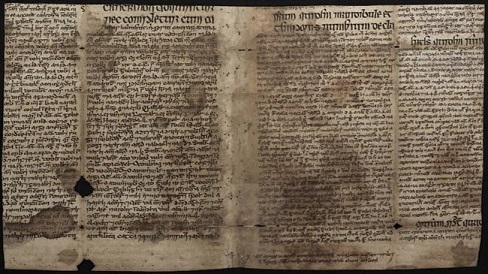
The discovery was made by Pádraig Ó Macháin of University College Cork's Irish Department — and has revealed that Irish doctors in the 1400s were exploiting medical knowledge from Persia.
It has also established that the famous Persian medical text, 'Canon of Medicine' by the Persian physician Ibn Sina (980–1037), also known as Avicenna, was in use in Ireland in medieval times for training young doctors, independent.ie reported.
The discovery arose from Ó Macháin becoming aware of a book in the possession of a British family which had links to Ireland.
The book — a pocket-sized Latin manual of local administration — was printed in London in 1534-1536. It had been in the possession of the British family, who are based in Cornwall, since that time. However, the book had a much older connection than the 16th century.
Ó Macháin studied photographs of the binding of the book —and realized it was a special cut-out from a 15th century Irish vellum manuscript.
It had been specially cut and stitched to the 16th century book in order to provide a sturdy spine.
"The use of parchment cut from old manuscripts as a binding for later books is not unusual in European tradition," Ó Macháin explained.
"This is the first time that a case has come to light of such a clear example of the practice in a Gaelic context."
Ó Macháin was also to determine that the inscriptions on the vellum involved some form of medical text.
"A quarter of what survives of late-medieval manuscripts in the Irish language is medical in content — an indication of the practical purpose of these books in Ireland of the time."
He decided to seek the assistance of Aoibheann Nic Dhonnchadha of the Dublin Institute for Advanced Studies, the only living expert on medieval Irish medicine.
Nic Dhonnchadha confirmed the historic nature of the discovery — the first recorded translation into Irish of the 'Canon of Medicine' by Ibn Sina.
The Persian medical researcher, also known as Avicenna, is known to history as one of the foremost physicians of the Islamic golden age of learning.
While it was suspected his texts must have been used by medieval Irish doctors in training, there had been no confirmed Irish translation of his work until now.
The spine of the 16th century book contains and Irish translation from a Latin translation of Ibn Sina's work which was effectively a general guidebook to medical practice.
The Irish fragment contains parts of the opening chapters on the physiology of the jaws, the nose and the back.
Ó Macháin said the discovery underlined just how much medical scholarship in medieval Ireland was on a par with that on the continent.
It was clear that some Irish scholar had traveled overseas to train — and had been so impressed by Ibn Sina's knowledge and work that they decided to use a Latin translation as the basis for an Irish translation.
Because of the importance of the manuscript fragment to the history of Irish learning and medicine, the owners kindly agreed that the binding should be removed from the book by John Gillis of Trinity College Dublin (TCD).
It was opened and digitized under the supervision of Ó Macháin. A new binding was then provided for the book.

Add new comment